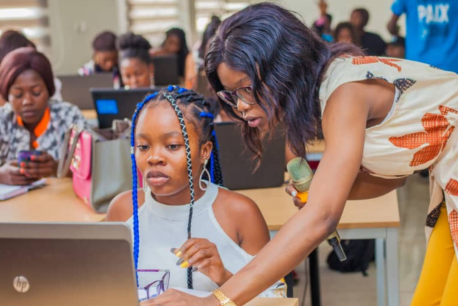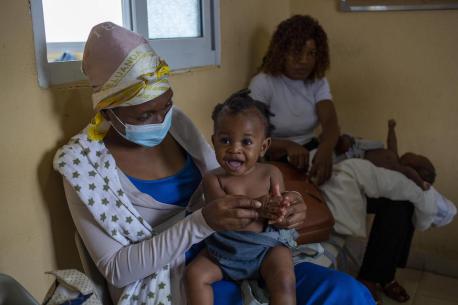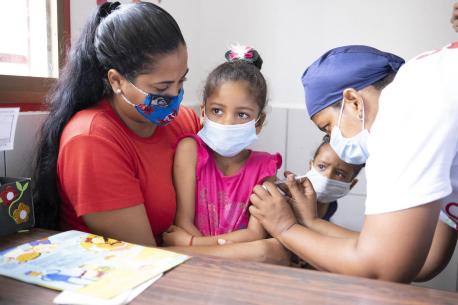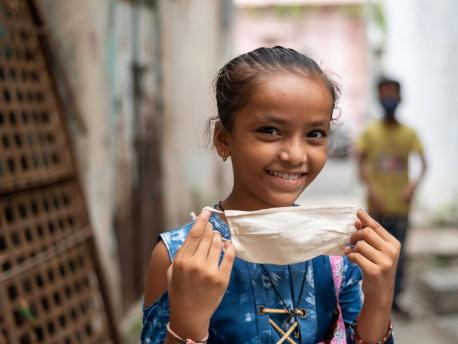
This Halloween, Trick-or-Treaters for UNICEF Can Help End the Pandemic
Trick-or-Treaters of all ages: Add meaning to your Halloween-ing by raising funds to support the largest vaccination campaign in history.
For decades, Trick-or-Treaters for UNICEF have made a huge difference for the most vulnerable children and families living in the world's toughest places. This Halloween, Trick-or-Treaters continue that tradition by taking on the most ambitious challenge yet. As part of COVAX, UNICEF is aiming to deliver 1.4 billion COVID-19 vaccine doses to 130-plus countries by the end of the year, and the funds Trick-or-Treaters for UNICEF raise will go toward that effort.
Ensuring that everyone gets their fair shot at a lifesaving COVID-19 vaccine is essential because no one is safe until everyone is safe. Ending the pandemic is also the only way to restart the world for children and get them the routine immunizations that keep them healthy, safeguard the lives of their parents, friends and loved ones and open their schools safely.
UNICEF won't stop until the fight against COVID-19 is won. But vaccines are only part of the job. Funds raised by Trick-or-Treaters for UNICEF will also provide diagnostics, therapeutics and the supplies everyone needs to protect themselves from COVID-19. Today, $1.80 buys 2 liters of hand soap. $37 will fund 2 doses of COVID-19 vaccine for 10 people. $50 can provide 161 face masks to keep frontline healthworkers safe.
A donation today, no matter how small, can go a long way. But back in 1947, when Trick-or-Treat for UNICEF founders Pennsylvania minister Clyde Allison and his schoolteacher wife, Mary Emma, started the movement to help European families who survived World War II, a dime was all it took to buy 50 glasses of milk for hungry children.
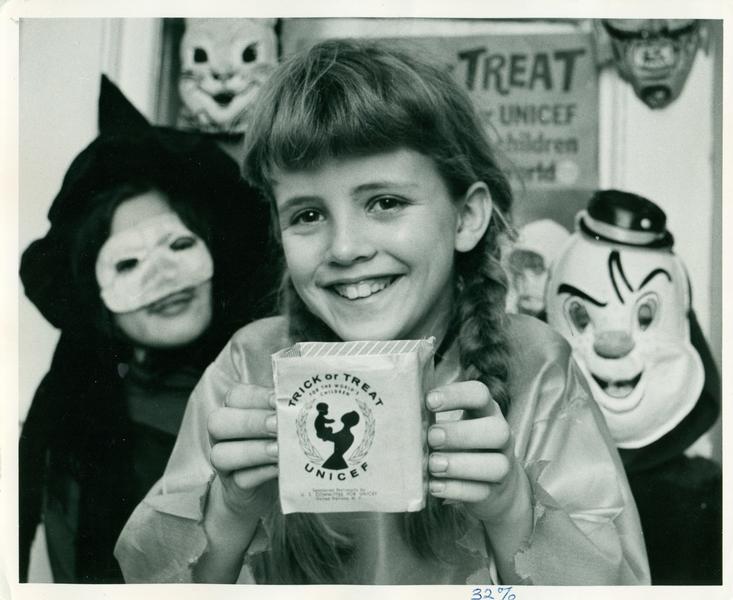
Trick-or-Treat for UNICEF went virtual last year to give everyone a chance to collect more donations than ever. This year we're taking the digital experience one step further by asking everyone 13 and older to start fundraisers to help end the pandemic. © UNICEF
Times sure have changed. And every year, Trick-or-Treat for UNICEF has morphed along with them to address the most significant threats to vulnerable children and families. This year, is no different. With the coronavirus hurting communities here and around the world, Trick-or-Treaters for UNICEF are needed now more than ever.
Here's how everyone can do their part: Visit trickortreatforunicef.org to register and start a fundraiser. If you’re 13 or older, you can fundraise on your own or with your family, team or another large group. You can also simply donate. Donations are another great way to support UNICEF’s equitable distribution of COVID-19 vaccines and supplies.
And, of course, younger kids can do their part, too! UNICEF Kid Power® has fun Halloween Kid Power Up videos they can do year-round for free to support kids in need locally and around the world.
How Trick-or-Treat for UNICEF began
Last year, the little orange Trick-or-Treat for UNICEF box went virtual so Trick-or-Treaters could celebrate Halloween safely and collect more donations than ever. This year we're taking the digital experience one step further by asking everyone 13 and older to start fundraisers to help end the pandemic. Although Trick-or-Treating for UNICEF will be different this year, the spirit of the program has stayed true to its founders' vision.
In 1947 — less than a year after UNICEF's founding — the Reverend Clyde Allison and his wife, Mary Emma, were handing out sweets to an endless parade of trick-or-treaters. The spectacle triggered conflicting emotions, as it still does among parents today.
Mary turned to her husband and said, “It's too bad we can't turn this into something good."
"We can," Clyde replied.
The following year, the Allisons and their children went trick-or-treating for clothing, soap and other goods for post-World War II relief efforts in Europe. But after the Halloween of 1949, the charity leading that effort disbanded. The family despaired, suddenly having nowhere to direct their donations — until one day, Mary Emma spotted a parade of children walking down one of Philadelphia’s main downtown streets. The destination? A booth collecting donations to support UNICEF.
A light bulb went on for Mary Emma, and it was an aha moment with far-reaching effects. That next Halloween, the Allisons’ children and friends collected coins for UNICEF in milk cartons they'd hand-painted, and the original Kids Helping Kids movement was born. Soon “Trick-or-Treat for UNICEF” became an annual chorus heard across the U.S., and children in Canada, France, Japan, Spain and the Philippines embraced the initiative. The campaign also drew the support of partners like Key Club International and the Kiwanis family along with the notice of presidents.

UNICEF won the 1965 Nobel Prize for programs like Trick-or-Treat for UNICEF that “proved compassion knows no national boundaries.” © UN Photo/Yutaka Nagata
"UNICEF has caught the imagination of our people, especially our nation's children." — President John F. Kennedy
In 1960, President John F. Kennedy noted "UNICEF has captured the imagination of our people, especially our nation's children ....” President Lyndon B. Johnson's signing of a proclamation that designated Halloween as National UNICEF Day seven years later cemented Trick-or-Treat for UNICEF's place in the hearts of America's public and culture.
Throughout the decades, everyone, from former U.S. Ambassador to the United Nations Susan Rice to former First Daughter Jenna Bush Hager has carried the little orange box. And celebrities, like Lassie, Kermit the Frog, Scooby Doo and the characters from Peanuts and Sony Pictures Entertainment’s “Goosebumps 2” have signed on to help promote Trick-or-Treat for UNICEF.
Trick-or-Treat for UNICEF's empowering impact has also earned it widespread support among a host of national partners. This year, UNICEF USA is particularly grateful to Key Club International and Circle K International for helping UNICEF meet this critical goal.
For over 70 years, Trick-or-Treaters for UNICEF have helped UNICEF ensure every child can survive and thrive. Learn more about Trick-or-Treat for UNICEF's history in this video.
Since Trick-or-Treat for UNICEF’s founding over 70 years ago, Trick-or-Treaters have helped UNICEF take on the biggest threats to children and families. And this year, will be no different because Trick-or-Treat for UNICEF's reasons for being remain constant:
1. Make Halloween meaningful as well as fun
2. Raise funds to help UNICEF solve some of the world's biggest problems
3. Inspire kids of all ages to aim for the most ambitious goals by working together
Top photo: Since the pandemic began, children around the world, like 13-year-old Sushmita from India, know that their masks are one of the best forms of protection against COVID-19. © UNICEF/UNI355865/Panjwani
HOW TO HELP
There are many ways to make a difference
War, famine, poverty, natural disasters — threats to the world's children keep coming. But UNICEF won't stop working to keep children healthy and safe.
UNICEF works in over 190 countries and territories — more places than any other children's organization. UNICEF has the world's largest humanitarian warehouse and, when disaster strikes, can get supplies almost anywhere within 72 hours. Constantly innovating, always advocating for a better world for children, UNICEF works to ensure that every child can grow up healthy, educated, protected and respected.
Would you like to help give all children the opportunity to reach their full potential? There are many ways to get involved.



